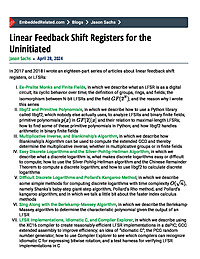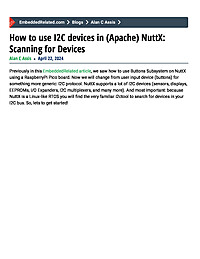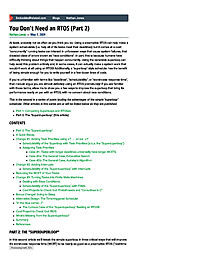
You Don't Need an RTOS (Part 2)
In this second article, we'll tweak the simple superloop in three critical ways that will improve it's worst-case response time (WCRT) to be nearly as good as a preemptive RTOS ("real-time operating system"). We'll do this by adding task priorities, interrupts, and finite state machines. Additionally, we'll discuss how to incorporate a sleep mode when there's no work to be done and I'll also share with you a different variation on the superloop that can help schedule even the toughest of task sets.
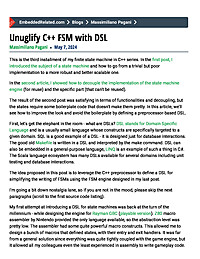
Unuglify C++ FSM with DSL
Domain Specific Languages (DSL) are an effective way to avoid boilerplate or repetitive code. Using DSLs lets the programmer focus on the problem domain, rather than the mechanisms used to solve it. Here I show how to design and implement a DSL using the C++ preprocessor, using the FSM library, and the examples I presented in my previous articles.
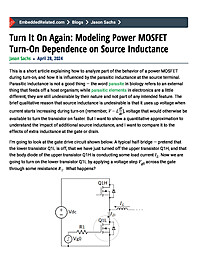
Turn It On Again: Modeling Power MOSFET Turn-On Dependence on Source Inductance
This is a short article explaining how to analyze part of the behavior of a power MOSFET during turn-on, and how it is influenced by the parasitic inductance at the source terminal. The brief qualitative reason that source inductance is undesirable is that it uses up voltage when current starts increasing during turn-on (remember, V = L dI/dt), voltage that would otherwise be available to turn the transistor on faster. But I want to show a quantitative approximation to understand the impact of additional source inductance, and I want to compare it to the effects of extra inductance at the gate or drain.
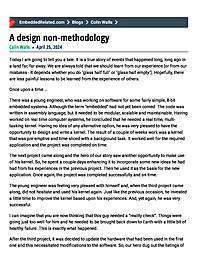
A design non-methodology
Although writing an RTOS or kernel may be an interesting project, it is unlikely to be a wise course of action.
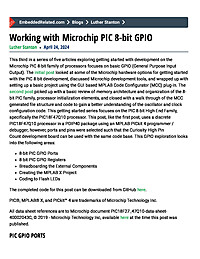
Working with Microchip PIC 8-bit GPIO
The third in a series of five posts looks at GPIO with PIC 8-bit microcontrollers. After a detailed review of the registers for configuring and managing GPIO on the PIC18F47Q10 processor, a basic application is stood up programming those registers to blink external LEDs at 0.5Hz.
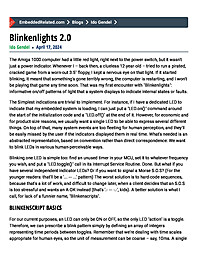
Blinkenlights 2.0
Nothing spells old movie computers like a panel of randomly blinking lights, but in fact, these so-called "blinkenlights" can be valuable indicators - especially in embedded systems where the user interface must be minimal, small and cheap. Control of these lights can be achieved using a very simple, real-time interpreted script, and this kind of solution may be extended to other and more complex embedded tasks.
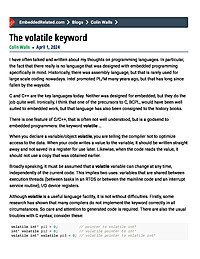
The volatile keyword
Although the C keyword volatile is very useful in embedded applications, care is needed to use it correctly and vigilance is required to ensure its correct implementation by compilers.
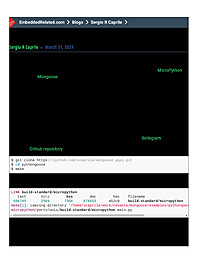
When a Mongoose met a MicroPython
This is more a framework than an actual application, with it you can integrate MicroPython and Cesanta's Mongoose.
Mongoose runs when called by MicroPython and is able to run Python functions as callbacks for the events you decide in your event handler. The code is completely written in C, except for the example Python callback functions, of course. To try it, you can just build this example on a Linux machine, and, with just a small tweak, you can also run it on any ESP32 board.
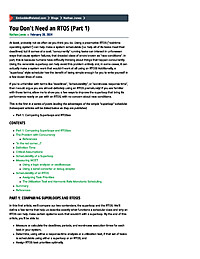
You Don't Need an RTOS (Part 1)
In this first article, we'll compare our two contenders, the superloop and the RTOS. We'll define a few terms that help us describe exactly what functions a scheduler does and why an RTOS can help make certain systems work that wouldn't with a superloop. By the end of this article, you'll be able to: - Measure or calculate the deadlines, periods, and worst-case execution times for each task in your system, - Determine, using either a response-time analysis or a utilization test, if that set of tasks is schedulable using either a superloop or an RTOS, and - Assign RTOS task priorities optimally.

You Don't Need an RTOS (Part 2)
In this second article, we'll tweak the simple superloop in three critical ways that will improve it's worst-case response time (WCRT) to be nearly as good as a preemptive RTOS ("real-time operating system"). We'll do this by adding task priorities, interrupts, and finite state machines. Additionally, we'll discuss how to incorporate a sleep mode when there's no work to be done and I'll also share with you a different variation on the superloop that can help schedule even the toughest of task sets.

The volatile keyword
Although the C keyword volatile is very useful in embedded applications, care is needed to use it correctly and vigilance is required to ensure its correct implementation by compilers.
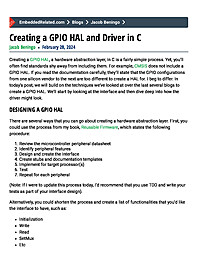
Creating a GPIO HAL and Driver in C
Creating a GPIO Hardware Abstraction Layer (HAL) in C allows for flexible microcontroller interfacing, overcoming the challenge of variability across silicon vendors. This method involves reviewing datasheets, identifying features, designing interfaces, and iterative development, as detailed in the "Reusable Firmware" process. A simplified approach prioritizes essential functions like initialization and read/write operations, showcased through a minimal interface example. The post also highlights the use of AI to expedite HAL generation. A detailed GPIO HAL version is provided, featuring extended capabilities and facilitating driver connection through direct assignments or wrappers. The significance of a configuration table for adaptable peripheral setup is emphasized. Ultimately, the blog illustrates the ease and scalability of developing a GPIO HAL and driver in C, promoting hardware-independent and extensible code for various interfaces, such as SPI, I2C, PWM, and timers, underscoring the abstraction benefits.

Cracking the (embedded) Coding Interview
You never forget the day you land your first job. The thrill of receiving that call from your recruiter to tell you that you bagged your dream role! The relief when you finally see the offer letter you’ve been working towards for...
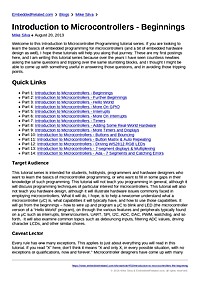
Introduction to Microcontrollers - Beginnings
Welcome to this Introduction to Microcontroller Programming tutorial series. If you are looking to learn the basics of embedded programming for microcontrollers (and a bit of embedded hardware design as well), I hope these tutorials will help you...
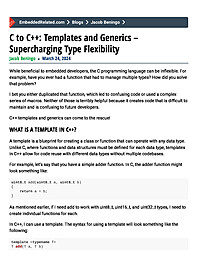
C to C++: Templates and Generics – Supercharging Type Flexibility
"C to C++: Templates and Generics – Supercharging Type Flexibility" illuminates the rigidity of C when managing multiple types and the confusion of code replication or macro complexity. In contrast, C++ offers templates, acting as type-agnostic blueprints for classes and functions, which allows for the creation of versatile and reusable code without redundancy. By using templates, developers can define operations like add once and apply them to any data type, simplifying codebases significantly. Generics further this concept, enabling a single code structure to handle diverse data types efficiently—a boon for embedded systems where operations must be performed on varying data, yet code efficiency is critical due to resource limitations. The blog walks through practical applications, showcasing how templates streamline processes and ensure type safety with static_assert, all while weighing the pros and cons of their use in embedded software, advocating for careful practice to harness their full potential.
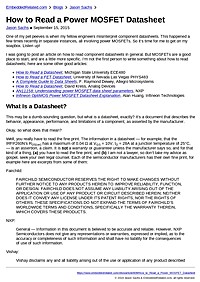
How to Read a Power MOSFET Datasheet
One of my pet peeves is when my fellow engineers misinterpret component datasheets. This happened a few times recently in separate instances, all involving power MOSFETs. So it’s time for me to get on my soapbox. Listen up! I was going to post...

When a Mongoose met a MicroPython
This is more a framework than an actual application, with it you can integrate MicroPython and Cesanta's Mongoose.
Mongoose runs when called by MicroPython and is able to run Python functions as callbacks for the events you decide in your event handler. The code is completely written in C, except for the example Python callback functions, of course. To try it, you can just build this example on a Linux machine, and, with just a small tweak, you can also run it on any ESP32 board.





